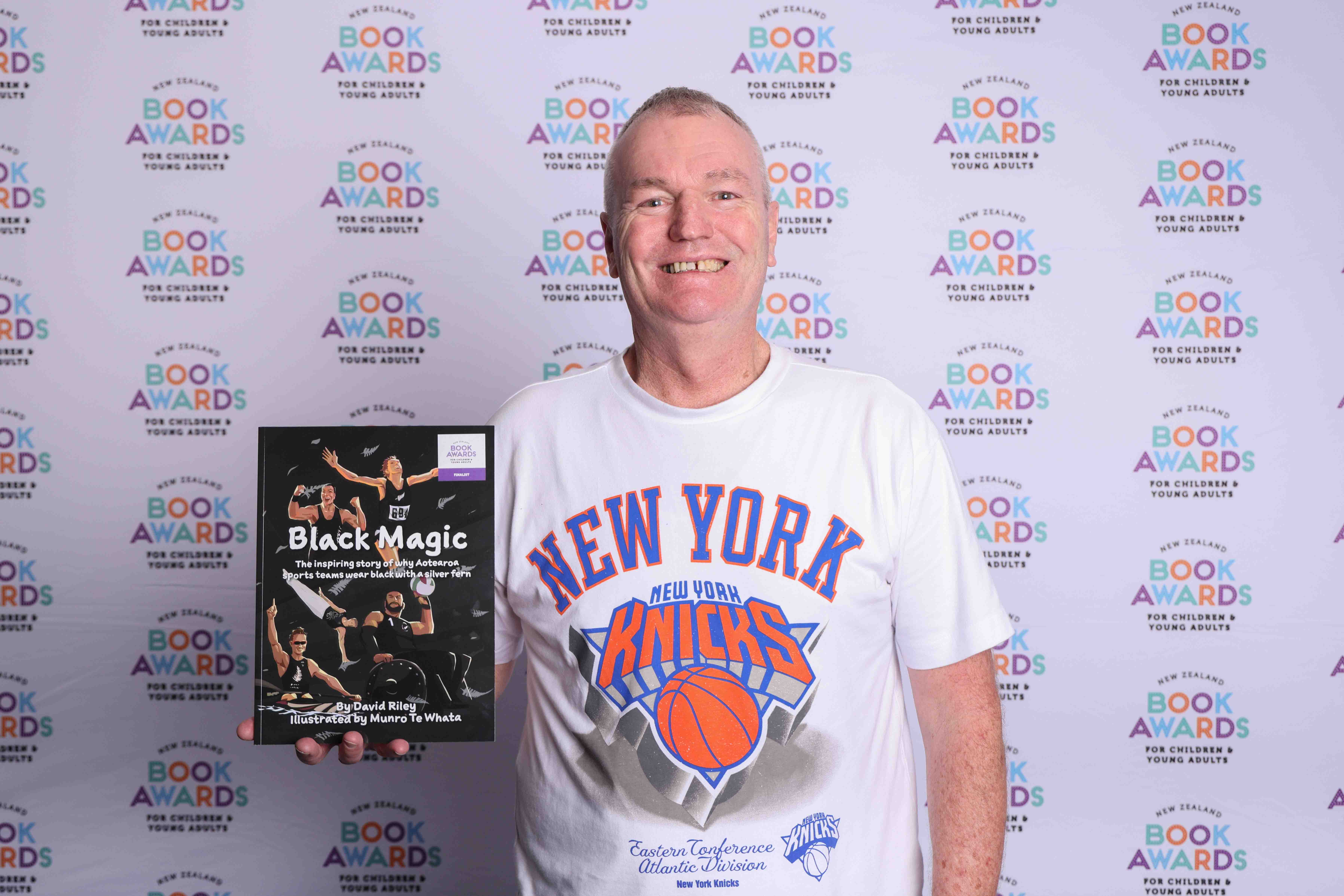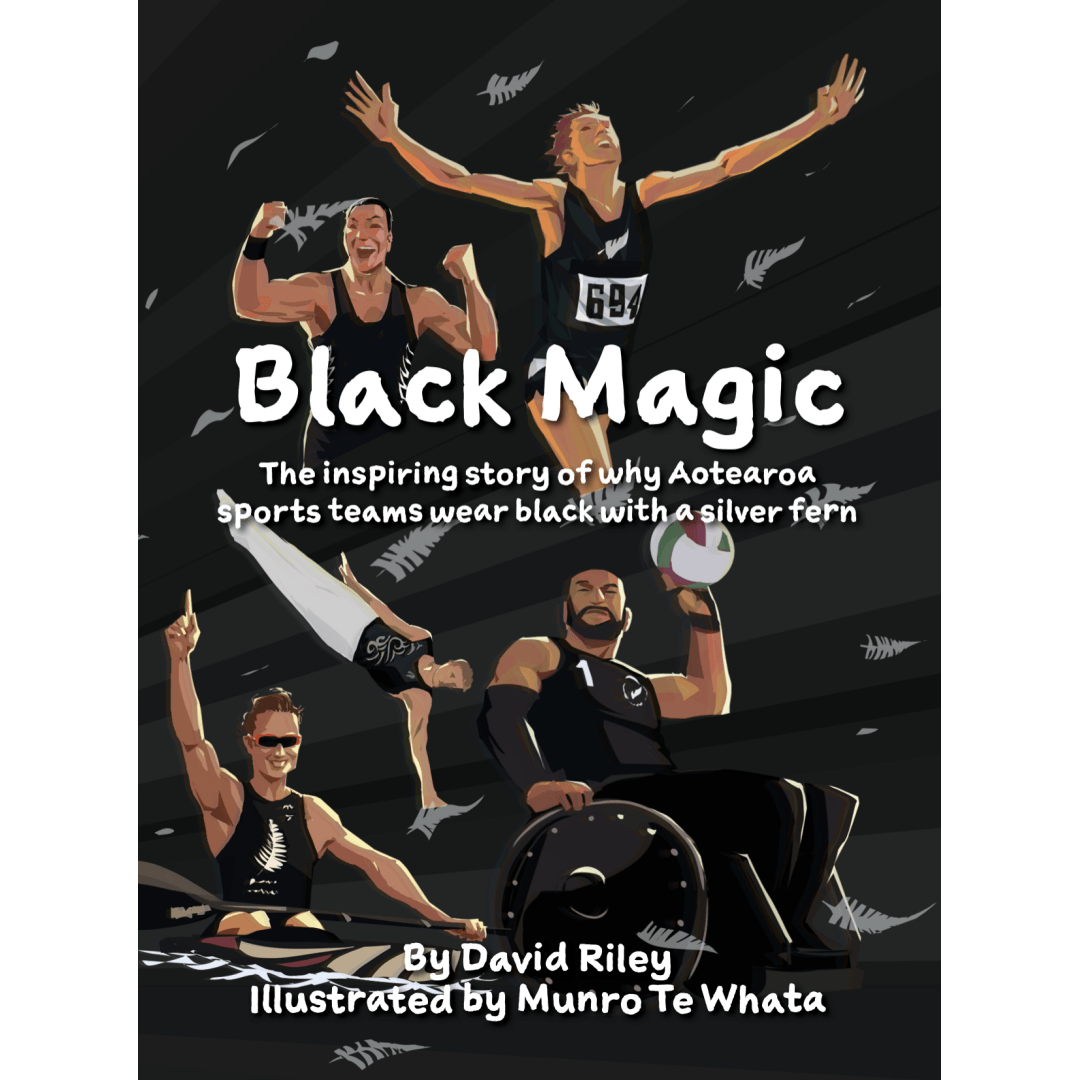Black Magic
Price range: $9.95 through $24.95 + GST
Aotearoa New Zealand’s national flag is blue, red and white … but our national colour is black with a silver fern.
How did this iconic look begin?
Discover the courageous and inspirational story behind our beloved national colours and sporting traditions in this action-packed adventure. Get ready to be captivated by the wonders of Black Magic!
Black Magic was shortlisted in the 2025 NZ Book Awards for Children and Young People.

“David Riley is a great storyteller and, in Black Magic, he tells a great story.” Trevor Agnew QSM
“David Riley’s Black Magic is a masterpiece of storytelling, weaving together ancient Polynesian voyages and the birth of New Zealand’s iconic sports uniform into a captivating narrative that will make every Kiwi’s heart swell with pride.” Selina Tusitala Marsh ONZM FRSNZ
Hear an interview about the book here:
Look inside the book:
Black Magic
Description
Paperback 978-1-991079-63-3
eBook (PDF) 978-1-991079-64-0
50 pages
210mm x 280mm






Reading Warrior –
David Riley’s “Black Magic” is a masterpiece of storytelling, weaving together ancient Polynesian voyages and the birth of New Zealand’s iconic sports uniform into a captivating narrative that will make every Kiwi’s heart swell with pride. Munro Te Whata’s stunning illustrations breathe life into the characters and events, creating a visual feast that perfectly complements David’s words. This book’s brilliant message about identity, representation, and cultural heritage is a must-read for all ages, reminding us of the power and significance behind the black jersey and silver fern that represent Aotearoa on the world stage.
Ahorangi Professor Selina Tusitala Marsh, ONZM, FRSNZ, NZ Poet Laureate
Reading Warrior –
David Riley is a great storyteller and, in Black Magic, he tells a great story, best summed up in his subtitle: The inspiring story of why Aotearoa sports teams wear black with a silver fern.
The epic journey of New Zealand’s first international Māori rugby team wasn’t just an unequalled set of records—107 rugby matches in 18 months—it also introduced the key features of Aotearoa New Zealand’s sporting wear. David Riley carefully tracks the origins of the silver fern and black sportswear back to Joseph Warbrick. He was a keen rugby player who wanted to tour a Māori team to Britain. When he had to include five Pākehā, his team was renamed the New Zealand Native Football Representatives, or more simply the New Zealand Natives. They were (almost) all born in New Zealand, shared daily karakia and performed a haka before every match.
David Riley is skilful in selecting key moments of the arduous tour, so his story flows smoothly and is always interesting. When they first see the haka, English supporters remark, Why are they dancing on a rugby field? The Natives were also the victims of the first ambush in international rugby when a local Middlesex team offered a friendly match. The team was full of ring-ins—English Scottish and Welsh international players. The organiser of the ring-ins was also the referee at a controversial match against England. When an English player’s trousers were torn in a tackle, the Natives formed a ring around him protecting their opponent’s mana as he changed. Meanwhile, an English player grabbed the ball and claimed a try.
Munro Te Whata’s colour illustrations are a perfect complement to Riley’s fast-moving narrative. He captures the period atmosphere with moustachioed players wearing below-theknee shorts. When the Natives have to play in a snowstorm in Carlisle, the illustration shows the goal-scoring players as black silhouettes on an almost completely white background. Another picture shows each player wearing a korowai. Every picture helps carry the story of how the national spirit and its sporting imagery has its roots in this arduous tour.
David Riley’s very readable account enables young readers to feel pride in the achievements of these rugby pioneers and their contribution to our sense of national feeling.
Trevor Agnew, QSM, Christchurch
Magpies. September 2024
Reading Warrior –
Radio NZ interview
Reading Warrior –
Hi David
Reaching out to say how much I have enjoyed Black Magic: The Inspiring Story of Why Aotearoa Sports Teams Wear Black with a Silver Fern.
On Thursday we, the Waikato Children’s Literature Association are having a Book Awards Review Night at Chartwell Library. I usually do the YA titles, this year Helen wanted to do a couple of them, so I said “Yes, and I’ll do Black Magic and Ten Nosy Weka!”
First, I read it, from start to finish, with great delight. Then went back and read it again, appreciating the migration back story behind Joseph Warbrick. The blend/combination of your words and Munro’s illustrations is so powerful. There is determination “We never quit”, respectful moments (the meaning of the colour black), the camaraderie, the energy of the haka and hilarity in the image of the Māori warrior in the British papers. As you say, “They literally put New Zealand on the Sports Map.” Oh, I like the variation in font size and colour too.
Today I discovered the Radio NZ interview with Kathryn and found myself nodding along as you spoke, familiar with your message and why you do what you do. “The illustrations draw out more meaning from the words than the words alone can provide.” This is something we usually talk about that in reference to picture books. How great it is for kids to have the same in such an engaging non-fiction book. And, as you say you are giving them knowledge that they in turn can share, like the ponga silver fern, leading the way home and so much more!
Gerri Judkins
Waikato Children’s Literature Association
Kids’ Lit Quiz Waikato